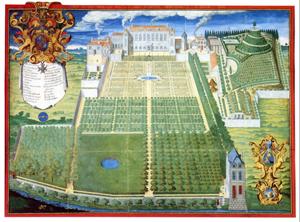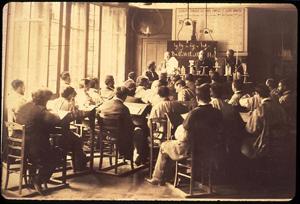History of Chemistry at the Museum

Le laboratoire au temps de Frémy (1814-1894)

Le laboratoire au temps de Frémy (1814-1894)
Chemistry is an historical discipline in the Museum National d’Histoire Naturelle.

Le laboratoire de chimie et le droguier du Roy en 1676 - Gravure de Sébastien Leclerc
The chemistry laboratory and medicinal drugs collection of the king in 1676. (Sébastien Leclerc )
Since the creation of « Jardin Royal des plantes Médicinales » in 1626, chemistry was taught along with botany and anatomy. The subject was taught by a professor with demonstrations that was carried out by a demonstrator. Many of these demonstrators marked the history of chemistry and often strived to counter the teachings of the professor through their experiences.
In 1647, chemistry teaching was handed over to the Scottish physician alchemist William Davisson: This is was the first free chemistry class taught to the public in France. Davisson’s successors transformed slowly the laboratory in the Royal garden into one of the highly animated chemistry laboratories of the 18th century. Among them, Guillaume-François Rouelle, also called Rouelle l’ainé was one of the important figures of his time: most of the great chemists belonging to the pre-revolution era such as Bayen, Bucquet, Darcet, Marcquer and especially Lavoisier were formed in his laboratory. Moreover, philosophers Denis Diderot and Jean-Jacques Rousseau too had followed Rouelle’s class in the Gardens and information about these classes are known to us through the notes of Diderot. Later, Fourcroy who was a “chimiste et conventionnel” taught Lavoisier’s new chemistry, of which he was a strong proponent in the Royal garden and in the Museum after 1793 .

Édit du Roy

Le Jardin du Roy - Gravure de F. Scalberge 1636
On 10 juin 1793, the « jardin de Roy » was renamed « Muséum national d’Histoire naturelle » and chemistry continued to develop with two chairs namely, general chemistry dedicated to theoretical chemistry and chemical arts dedicated to applications of chemistry. Later in1850, they were known as «Applied organic chemistry » and « Applied inorganic chemistry » .
Personalities such as Nicolas Vauquelin, Joseph Gay-Lussac, Michel Eugène Chevreul marked both the fields through their work and teachings. Edmond Frémy, the last professor of inorganic chemistry deserves a special mention. In 1864, period when chemical engineering schools did not exist in France, Fremy created his chemistry school in the Museum that offered free courses and gave greater importance for experiments. He was the one who inaugurated in December 1872, the building situated at 63, rue Buffon where stands the actual chemistry laboratory. Between 1864 to 1892 , after which the school was abolished, more than 1400 students were formed who later became the artists of the chemical industry and university research and the well known among them are Henir Moissan, first french who was awarded Nobel prize in chemistry (1906), Léon Arnaud, Alexandre Etard, Gabriel Bertrand, Auguste Verneuil, Henri Becquerel, Jacques Curie.

Les cours publics de Chimie par Gay-Lussac puis Frémy
Chemistry classes for the public by Gay-Lussac and later by Fremy.

Le laboratoire au temps de Frémy (1814-1894)

Les cours publics de chimie par G. Lussac
Naviguez à travers quatre siècles d'histoire(s) de la chimie au Muséum racontés dans un long récit animé.

Découvrir le récit animé "Petite histoire de la chimie au Muséum"
List of professors and demonstrators
|
Chair n°1 Professor |
Chair n°2 Demonstrator |
|---|---|
|
Urbain BAUDINOT |
William DAVISSON |
|
Guy Crescent FAGON |
Nicaise LE FEBVRE |
|
Suppl.: Simon BOULDUC |
Christophe GLASER |
|
Suppl.: Antoine de SAINT YON |
Moyse CHARAS |
|
Suppl.: Etienne-François GEOFFROY |
Sébastien MATTE |
|
Etienne-François GEOFFROY |
Simon BOULDUC |
|
Louis LEMERY |
Gilles-François BOULDUC |
|
Louis-Claude BOURDELIN |
Guillaume-François ROUELLE |
|
Pierre-Joseph MACQUER |
Hilaire-Marin ROUELLE |
|
Antoine François FOURCROY |
Antoine Louis BRONGNIART |
List of professors
|
general chemistry |
chemicals arts |
|---|---|
|
Antoine François FOURCROY |
Antoine Louis BRONGNIART |
|
André LAUGIER |
Louis-Nicolas VAUQUELIN |
|
Joseph Louis GAY-LUSSAC |
Michel-Eugène CHEVREUL |
|
Chemistry applied to inorganics bodies 1850 |
Chemistry applied to organics bodies 1850 |
|---|---|
|
Edmond FREMY |
Michel-Eugène CHEVREUL |
|
Léon-Albert ARNAUD |
|
|
Louis-Jacques SIMON |
|
|
Richard FOSSE |
|
|
Charles SANNIE |
|
|
Charles MENTZER |
|
|
Darius MOLHO |
|
|
Pierre POTIER |
|
1710 |
First use of solvents to prepare vegetal extracts by Simon Boulduc |
|
1773 |
Urea isolation by Hilaire-Marin Rouelle |
|
1797 |
Discovery of chromium from crocoite (lead chromate) and of glucine (beryllium oxyde) from emerald, by Nicolas Vauquelin |
|
1810-1823 |
Research on fatty acids by Chevreul. Isolation of cholesterol from gallstones (1813) and isolation of the main fatty acids from animal fats: stearic acid, margaric acid, oleic acid, butyric acid, capric acid and caproic acid. Chevreul determined their composition and explained the process of saponification. He developped from this research an important application : the stearic candle (1834) |
|
1832 |
First isolation of flavones: luteolin and morin, by Chevreul |
|
1835 |
Isolation of creatin from meet broth, by Chevreul |
|
1839 |
Publication of the famous law of simultaneous contrast of colours, by Chevreul |
|
1840 |
Isolation of palmitic acid from palm oil, by Edmond Frémy |
|
1853 |
Determination of the nature of ozone, by Edmond Frémy and Edmond Becquerel |
|
1854 |
Preparation anhydrous hydrofluoric acid by Edmond Frémy. His work will permit the discovery of fluor by his student Henri Moissan, who will obtain the Nobel Prize in Chemistry in 1906. |
|
1864 |
Publication a method of classification of colours by Chevreul: The chromatic circles. His classification and theory of colour contrast influenced the Neo-Impressionism developed by Georges Seurat and Paul Signac. |
|
1888 |
Synthesis of ruby by Auguste Verneuil and Edmond Frémy Isolation of ouabain by Léon-Albert Arnault and development as cardiotonic drug |
|
1892 |
Isolation of tariric acid (first acetylenic fatty acid) by Léon-Albert Arnault |
|
1898 |
Biochemical preparation of sorbose by Gabriel Bertrand |
|
1907 |
Development of a gravimetric method for the determination of urea by precipitation as xanthylium salt, by Richard Fosse |
|
1926 |
Preparation of Solucamphre (camphorsulfonate of diethylenediamine), a cardiotonic medicine, by Marcel Frèrejacque |